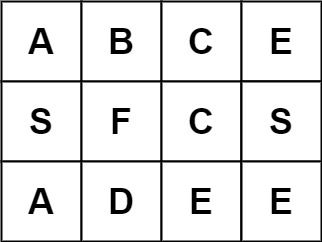Given an m x n grid of characters board and a string word, return true if word exists in the grid.
The word can be constructed from letters of sequentially adjacent cells, where adjacent cells are horizontally or vertically neighboring. The same letter cell may not be used more than once.
Example 1:
Input: board = [["A","B","C","E"],["S","F","C","S"],["A","D","E","E"]], word = "ABCCED" Output: true
Example 2:
Input: board = [["A","B","C","E"],["S","F","C","S"],["A","D","E","E"]], word = "SEE" Output: true
Example 3:
Input: board = [["A","B","C","E"],["S","F","C","S"],["A","D","E","E"]], word = "ABCB" Output: false
m == board.lengthn = board[i].length1 <= m, n <= 61 <= word.length <= 15boardandwordconsists of only lowercase and uppercase English letters.
Follow up: Could you use search pruning to make your solution faster with a larger board?
class Solution:
def exist(self, board: List[List[str]], word: str) -> bool:
def dfs(row, col, index):
if index == len(word):
return True
if row < 0 or col < 0 or row >= len(board) or col >= len(board[0]) or board[row][col] != word[index]:
return False
temp = board[row][col]
board[row][col] = '#' # Mark as visited
found = (dfs(row + 1, col, index + 1) or dfs(row - 1, col, index + 1) or
dfs(row, col + 1, index + 1) or dfs(row, col - 1, index + 1))
board[row][col] = temp # Backtrack
return found
for row in range(len(board)):
for col in range(len(board[0])):
if dfs(row, col, 0):
return True
return FalseThe time complexity of this solution is O(M X N X 4^L), where M and N are the dimensions of the board, and L is the length of the word. This is because, in the worst case, we might need to explore all 4 directions for each character in the word.
The space complexity is O(L) for the recursion stack, where L is the length of the word. In the worst case, the word could be as long as the number of cells in the board.


